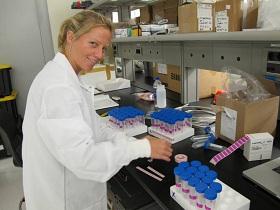Using AI to control energy for indoor agriculture
30 September 2024
Published online 18 August 2011

In a bid to better understand how Red Sea corals are responding to climate change and human activity, the King Abdullah University of Science and Technology (KAUST) is building a floating research station, which will be the largest reef monitoring station in the Red Sea.
The station will be run by KAUST's Red Sea Research Center (RSRC) and will be fully operational within five years. "We have, for the time being, chosen three reefs in total where we deploy sensor setups and tile frames to continuously monitor physico-chemical and biological parameters," says Cornelia Roder, a coral reef ecologist at KAUST.
The station will eventually cover several more reefs in the Red Sea, adds James Luyten, director of RSRC.
Conductivity-temperature-depth (CTD) instruments were deployed to measure changes in temperature and salinity with depth, and Acoustic Doppler Current Profiler (ADCP) sensors to record currents and wave patterns. Permanent nutrient sensors at the station will monitor changes in inorganic nutrients such as nitrates, ammonium, phosphates and silicates.
"We have also deployed limestone tiles to monitor bioerosion and bioaccretion, terracotta tiles to monitor biofouling and glass tiles to monitor algal growth," adds Roder.
Researchers at RSRC will be able to use the data gathered to study microbial assemblages of coral reefs and physical and biological stressors. "We also do regular transect work to describe the changes in substrate cover and we collect coral samples to analyze health indicators, biomass and other metabolic parameters," says Roder.
"We hope to be able to gather all the data together to be able to model coral reefs and how they respond to changes in any of the parameters," said Christian Voolstra, a marine scientist at KAUST. "Currently we have very limited understanding of how coral reefs behave over annual cycles. This project aims to understand the seasonal patterns of coral reefs."

Most climatic information of coral reef habitats was gleaned from equipment deployed discreetly in the reefs or by remote sensing imagery, explains Chris Fulton, an evolutionary marine biologist at the Australian National University in Canberra. "By providing long-term datasets, collected in real time and at scales meaningful to the biology and ecology of coral reef organisms, the establishment of these coral monitoring stations will revolutionize how we explore the response of coral reefs to changing climates."
Luyten hopes the station will incorporate ecological surveys and oceanographic measurements into a comprehensive study of all the reefs near KAUST to get an idea of the variability in the region and what impact climate change is having on the reefs. "We hope as part of this effort to be able to limit access to these reefs so that the results are less impacted by fishing and other activities."
Fulton is optimistic work at the new station will provide much needed quantitative data on both the environmental conditions and the response of corals. "Coral reefs in the Red Sea experience some of the warmest water temperatures in the world, so this information may help shed light on how corals in other parts of the world may respond to increasing water temperatures as a result of global climate change."
doi:10.1038/nmiddleeast.2011.108
Stay connected: